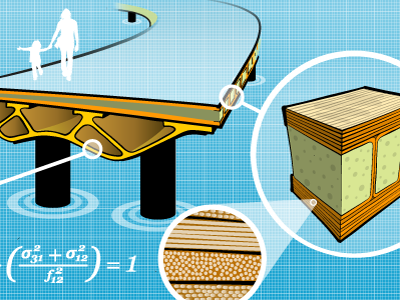Bio-based Bridge
For the first time in history, a bio-based movable bridge for cyclists was built in the province of Friesland, the Netherlands. The bridge, which is 66 metres long and 4 metres wide, is open since early 2020. Compared to the old concrete bridge of 400 tonnes, this bio-composite bridge is only 30 tonnes.
The bridge is made out of flax and resins derived from plants and it’s the first time this bio composite material is used on this scale. It stands as an important project and example to promote more eco-friendly materials and sway the construction industry to turn to a greener page.
Tested at TU Delft’s laboratories
After clicking on a series of buttons, Assistant Professor Dr. Marko Pavlović turns on a machine. Two pistons, one per side, start a rhythmic up-and-down bending of the structure’s extremities. This was a 1:3 scale replica of the swing bridge, designed to pivot horizontally around a central pin. “Regarding flexibility, the structure is very promising,” comments Pavlović. “It behaves like chewing gum, and it is very strong.”
Bio-based is the new black
The machine kept on running for weeks under Pavlović’s eye. Bending, hammering, twisting and loading the structure to simulate how deformations affect it when crossed, or while opened and closed for 30 times a day for a lifetime of 100 years. Pavlović set his heart on this research as an expert in Structural Engineering and Fibre Reinforced Polymer (FRP) composites — obtained by mixing two or more different constituent materials. He aims to present the bridge in one piece and without significant deformations to the conservative construction industry. To prove once more that there is more to play with than the classic trio of Concrete, Steel and Wood. “Concrete suffers corrosion of the embedded steel reinforcement within 30-40 years of its lifetime, and steel needs repainting every 20 years to avoid corrosion to impact the structure’s performances,” says Pavlović. “The bio-based composite material used for the bridge — laminated and painted to resist UV rays and moisture — aims to achieve more durability and less maintenance than traditional steel.”
Research and sacrifices to slow down global warming
“We must learn to reduce our comfort standards to slow down emissions from human activities,” says Pavlović. The construction industry, at the moment, is responsible for 39% of energy-related CO2 emissions on Earth. It is mandatory that Civil Engineering plays its part to increase the funds into research for solutions with lower carbon footprints. “This means investigating new solutions to use greener materials and sacrifice comfort if needed. For instance, letting structures shake a little more when stepping on them, without compromising their safety.”
Greener materials for more sustainable economies
More innovative businesses like sport and automotive, already use bio-based materials. Such industries have lighted the starry night to inspire engineers like Pavlović to research new fruitful routes while promoting innovation and more circular economies. “Looking out of the box is the key”, says Pavlović. “By doing that, it soon came out that composite materials can be used in Civil Engineering as well. If well-designed, bio-based structures could be crafted out of modular parts similar to LEGO, to be re-used in new constructions after periods of 50 years.”
Setting foot onto the future
Now that pedestrians and cyclists cross the world's first movable bio-based composite bridge every day, “I hope they do not only feel safe but, that they also understand the message of the structure,” comments Pavlović. “If you are brave enough to look for alternatives, you can make the world a better place for yourself, your family and many more generations to come.”
 FRP Composites in Structural Engineering
FRP Composites in Structural Engineering
Are you interested in learning how to start or progress the application of FRP in your projects -and need relevant knowledge and experience?
Contribute to sustainability by extending the lifetime of new and existing structures. Fiber Reinforced Polymers (FRPs) are the new high-performance composite material in building and infrastructure projects. They are light, durable and strong.
In this 100% online course offered by the Delft University of Technology (TU Delft) you can now learn how to design and build with FRPs.
Go to course page and find out more